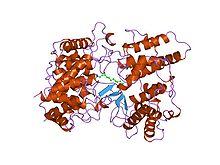| Prenyltransferase and squalene oxidase repeat | |||||||||
|---|---|---|---|---|---|---|---|---|---|
 Structure of a squalene cyclase.[1] | |||||||||
| Identifiers | |||||||||
| Symbol | Prenyltrans | ||||||||
| Pfam | PF00432 | ||||||||
| Pfam clan | CL0059 | ||||||||
| InterPro | IPR001330 | ||||||||
| PROSITE | PDOC00825 | ||||||||
| SCOP2 | 1sqc / SCOPe / SUPFAM | ||||||||
| OPM superfamily | 37 | ||||||||
| OPM protein | 1w6k | ||||||||
| |||||||||
Prenyltransferases are a class of enzymes that transfer allylic prenyl groups to acceptor molecules. Prenyl transferases commonly refer to prenyl diphosphate syntheses.[2]
Prenyltransferases are commonly divided into two classes, cis (or Z) and trans (or E), depending upon the stereochemistry of the resulting products. Examples of trans-prenyltranferases include dimethylallyltranstransferase, and geranylgeranyl pyrophosphate synthase. Cis-prenyltransferases include dehydrodolichol diphosphate synthase (involved in the production of a precursor to dolichol).
The beta subunit of the farnesyltransferases is responsible for peptide binding. Squalene-hopene cyclase is a bacterial enzyme that catalyzes the cyclization of squalene into hopene, a key step in hopanoid (triterpenoid) metabolism.[1] Lanosterol synthase (EC 5.4.99.7) (oxidosqualene-lanosterol cyclase) catalyzes the cyclization of (S)-2,3-epoxysqualene to lanosterol, the initial precursor of cholesterol, steroid hormones and vitamin D in vertebrates and of ergosterol in fungi.[3] Cycloartenol synthase (EC 5.4.99.8) (2,3-epoxysqualene-cycloartenol cyclase) is a plant enzyme that catalyzes the cyclization of (S)-2,3-epoxysqualene to cycloartenol.
Human proteins containing this domain
References
- ^ a b Wendt KU, Poralla K, Schulz GE (1997). "Structure and function of a squalene cyclase". Science. 277 (5333): 1811–1815. doi:10.1126/science.277.5333.1811. PMID 9295270.
- ^ Takahashi S, Koyama T (2006). "Structure and function of cis-prenyl chain elongating enzymes". The Chemical Record. 6 (4): 194–205. doi:10.1002/tcr.20083. PMID 16900467.
- ^ Prestwich GD, Poralla K, Hewelt A, Abe I, Reipen I, Sprenger G (1994). "A specific amino acid repeat in squalene and oxidosqualene cyclases". Trends Biochem. Sci. 19 (4): 157–158. doi:10.1016/0968-0004(94)90276-3. PMID 8016864.
External links
- Prenyltransferase at the US National Library of Medicine Medical Subject Headings (MeSH)
- Protein prenyltransferases alpha subunit repeat in PROSITE